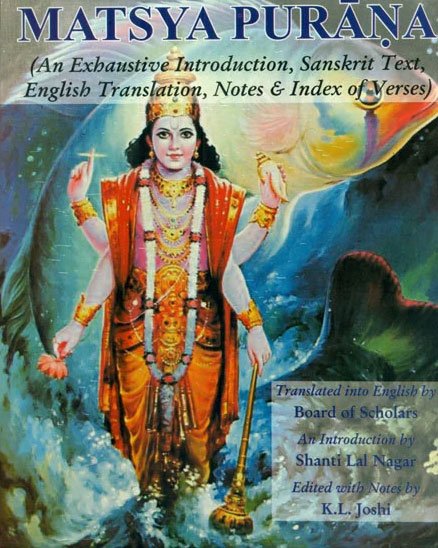The Matsya Purana (critical study)
by Kushal Kalita | 2018 | 74,766 words | ISBN-13: 9788171103058
This page relates ‘Dana (donation—the practice of cultivating kindness)’ of the English study on the Matsya-purana: a Sanskrit text preserving ancient Indian traditions and legends written in over 14,000 metrical verses. In this study, the background and content of the Matsyapurana is outlined against the cultural history of ancient India in terms of religion, politics, geography and architectural aspects. It shows how the encyclopedic character causes the text to deal with almost all the aspects of human civilization.
Part 5 - Dāna (donation—the practice of cultivating kindness)
From the foregoing discussion it is clear that vratas occupied an important place among the religious rites performed by the people of the time of the Matsyapurāṇa. The Purāṇa contains the descriptions of the largest number of vratas and upavāsas. It is clear that the vratas are the substitutes of difficult and reserved Vedic sacrifices which were meant only for the three upper castes. But vratas found in the Matsyapurāṇa and other Purāṇas can be performed by even the śūdras and women. From the social point of view it is, thus, clear that the vrata in the Matsyapurāṇa is not just an oblation to gods and goddesses, rather, it is directly concerned with the social and moral life. Through the saṅkalpa of a vrata one not only starts the vrata but also ropes him with all good things and stays away from all bad things. Upavāsa or Fast is a way of gaining internal purity which refreshes one’s body. This is the central point of all vratas of the Matsyapurāṇa. The internal purity also comes from penance in the form of chanting mantras and worshipping gods etc. There are hardly any vrata which runs without worship and without chanting any mantra.
Dāna is shown as the most necessary part of a vrata in the Matsyapurāṇa. Without it vrata remains incomplete and fruitless. The vratas of Matsyapurāṇa bear great social value through dāna which is based on dayā, tyāga and samatā. It is clearly mentioned in the Matsyapurāṇa on the description of Saṃkrāntivrata that donation should be made to poor or to needy brāhmaṇa only. The ethics of the dāna consist in the fact that it benefits both the giver and the receiver. Dāna can work for reducing poverty and produce equality in the society. It can be also noticed that for almost all the vratas dāna is made to the brāhmaṇa caste only. The reason of this may be that as at that time brāhmaṇas were not permitted to do menial works so they had to depend on the donation of others. In this way they were encouraged to remain engrossed in the spread of education which was their main duty. Another important thing about dāna mentioned in the Matsyapurāṇa is that though donation of many costly things like gold, silver, jewels etc. are enjoined here, alternatives for the poor people are also prescribed here. In this way poor people are also enabled to perform vratas. Thus vrata and dāna promotes social harmony among all castes.
Dāna normally means donation. It is the practice of cultivating kindness. In the Manusaṃhitā, it is stated that that the principal aspect of religious life in the kaliyuga was gift.[1] From the period of the Vedas downwards, the eulogies for dāna have been found. The Ṛgveda has dealt with the dāna many times. It has eulogized dāna and praised the donor in many places.[2] The Ṛgveda lauds the giver of food and condemns the decliner of it. It is said that one who does not offer food to the gods or to his friends who is in need and uses it for his own purpose only, is a sinful person.[3] Again, in this Veda it is also mentioned that those who make gifts of dakṣinā (sacrificial fee gifted to the performer of the ritual on behalf of the devotee) stand high in heaven.[4]
In the Bṛhadāraṇyakopaniṣad, it is said that one should learn three cardinal virtues, viz.,
- self restraint,
- charity and
- compassion for all life.[5]
The Chāndogyopaniṣad also states that a virtuous life requires:
The Anuśāsanaparva of the Mahābhārata broadly discussed the various aspects of dāna.[7] In the Manusaṃhitā also, gifts of different kinds are highly praised.[8]
The Śrīmadbhagavadgītā divides dāna in to three parts, viz.,
The Purāṇas recommend several dānas as means of achieving salvation and other divine feat. Almost all the Purāṇas deal with dāna. In the Purāṇas, dāna remains an integral and attached part of Vratas. In most of the vratas, at the end of the rituals, the devotee makes donation to the preceptor or brāhmaṇas which are discussed earlier. Apart from these, the Matsyapurana has also broadly discussed dāna as an independent ordinance.
Along with some normal dāna it has elaborated sixteen (16) types of mahādānas and ten (10) types of merudānas.
Thus, it is evident that the sixteen mahādānas and ten merudānas are the most expensive ordinances which require huge quantities of gold, jewels, lands and many other valuable articles. One can perform such ordinance only if he has such kind of property. It not only reflects the religious part of the Purāṇic time but also indicates that for India it was a golden era where people were capable of donating such a huge quantity of gold and other valuable articles.
Footnotes and references:
[1]:
dvāpare yajñamevāhurdanamekam kalau yuge/ Manusaṃhitā, I.86
[2]:
Ṛgveda, I.125.5-7; I.126.1-5; VI.47.22-25; VIII.6.46-48
[3]:
Ibid., X 1l7.6
[4]:
Ibid., X.107.2,7-8
[6]:
Chāndogyppaniṣad, III
[7]:
Mahābhārata, 13.62.19; 13.59.5
[8]:
Cf., Manusaṃhitā, 4.228-234
[9]:
Śrīmadbhagavadgītā, 17.20-22
